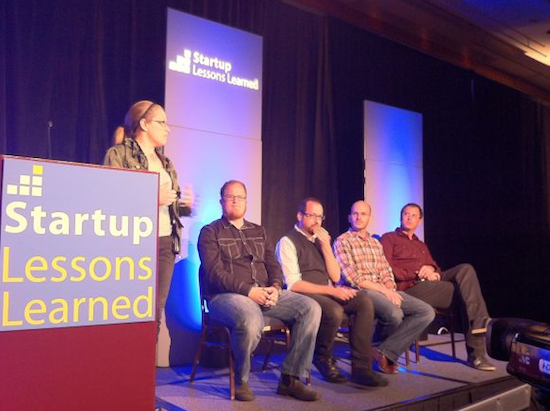We’re back from lunch and onto a very interesting session consisting of four back-to-back case studies. These case studies are focused on lean user experience design.

It’s important to remember that a lean startup doesn’t just mean a startup that runs lean financially. It’s about running the company lean across the board and doing quick and effective use interface design is just another piece of the puzzle.
UX Cycle
- Think – research, ideation, mental models
- Make – prototypes, wireframes, value prop
- Check – A/B testing, site analytics, usability testing
Don’t spend 8-weeks just thinking! Do some thinking and then do some making!
Principles of Lean UX:
- Recognize hypotheses and validate them
- FLOW: think/make/check
- Research with users is the best source of information
- Goal-Driven and Outcome-Focused
- Generate many options and decide quickly which to pursue
Reduce the amount of time between making a design decision and then determining if it is good or bad.
Product Stewardship (led by Tim McCoy from Cooper)
- Creating an environment where your product can flourish.
- Thoughtful management
- Not about getting your task list completed but instead having responsibility of something that you are taking care of and leaving it in better hands than when you showed-up
- It is a shared responsibility between businesses stakeholders, users+customers, and the product team
How The Ladders Got Out of the Deliverables Business (led by Jeff Gothelf)
- Tactic 1: Style Guides
- Tactic 2: Collaborative problem solving – get the teams solving problems together
- Tactic 3: Pairing saves time and levels the playing field (pairing designers with developers)
- Big Learning #1: Human to human communication is much better than paper to paper communication
- Big Learning #2: Get ready for new ways of working
How to Work with a Designer (led by Josh Seiden from LUXr NYC)
- Work with the designers, rather than just giving them assignments get-together with them
- Designers do customer development
- Designers want to understand how to solve a problem
- Designers research reveals what users value
- Designers need organizational support
How SideReel Hit The Jackpot (led by Zach Larson from SideReel)
- Information radiator – large display of critical team information
- What’s a successful information radiator? Information light, cheap to build and maintain, informs discussion so that conversations are richer
- Completely re-did design, scary thing to do but made all the difference in the world
- When to make an information radiator? When people are asking for the same info, when there is a core set of information to share, when the people who see it will share a context, when people find it useful
